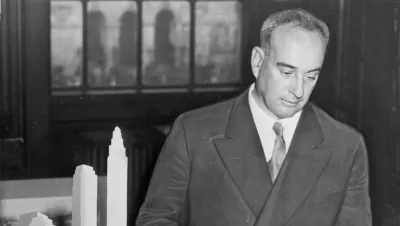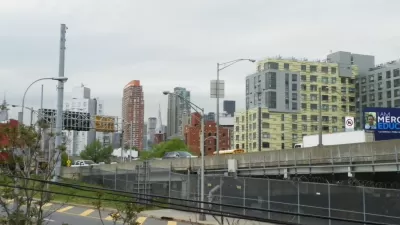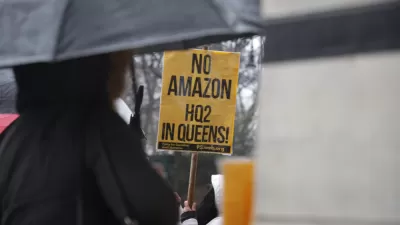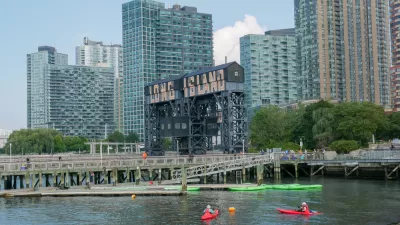Last week, Amazon abruptly canceled its decision to invest about $2.5 billion and bring 25,000 high-paying jobs to Queens. A scholar blames their abrupt decision on an arcane state bureaucracy tasked with preventing Robert Moses-like takings.

As noted in a New York Times analysis of Amazon's cancellation of HQ2 on Valentines Day, "Amazon could have worked with the deal’s biggest champions, Gov. Andrew Cuomo and Mayor Bill de Blasio, to push past the limited public hostility," writes Marc J. Dunkelman, a fellow at Brown University’s Watson Institute for International and Public Affairs, and the author of “The Vanishing Neighbor: The Transformation of American Community."
However, even if a deal had been reached between the governor, the mayor, and Jeff Bezos, Dunkelman writes that "no amount of leverage is capable of overcoming resistance from a small star chamber in Albany known as the Public Authorities Control Board. Without unanimous support from the three voting members of the PACB, Amazon’s plan was dead in the water."
More specifically, Dunkelman points to an appointment to the board earlier this month.
"On [Feb. 4], the New York state Senate announced that it was appointing state Sen. Michael Gianaris [D] to represent the legislative body on the Public Authorities Control Board, reported Annie McDonough for City & State New York on Feb. 5.
Gianaris, whose Queens district includes Long Island City, has been one of HQ2’s most vocal critics, and his appointment to the PACB has been seen by some as an attempt to stop HQ2 in its tracks.
How did this board acquire so much power?
Public Authorities Control Board and Robert Moses
"After roughly 40 years as New York’s master builder, Moses was shown the door by Gov. Nelson Rockefeller [from 1967-1968]," writes Dunkelman.
By then, the public was seething and New York seemed to be on the decline. The PACB is one of a raft of new tools established in the wake of Moses’ reign to check the power of government to build new public works and other redevelopment projects.
To be sure, the board was created by Gov. Hugh Carey [D] in 1976 "in the aftermath of a state fiscal crisis in which the New York state Urban Development Corporation and the New York state Housing Finance Agency were thought to have overstretched themselves and incurring too much debt in building projects, according to a former member of the board," wrote McDonough for City & State
Included in Dunkelman's "raft of new tools" to check government power are:
- New York City Mayor Robert F. Wagner creating the Landmarks Preservation Commission in 1965 in response to the loss of Pennsylvania Station in 1963.
- President Nixon's signing the National Environmental Policy Act in 1969 to establish an elaborate environmental review process for major projects to safeguard the environment.
- Strengthening of NYC zoning laws enabling residents to slow or even kill projects.
This is really the meat of Dunkelman's essay – that laws and boards have been given so much power in the aftermath of the physical destruction caused by Moses' projects that even good development can be halted too easily.
Moses’ mark often left a scar. But for policymakers—and particularly for progressives whose aim it is to use public power for the public good—the hurdles erected in his wake make the process of doing great things next to impossible. The scar tissue built over the past 50 years to prevent the second coming of Moses stops good projects as well as bad.
For example, "[f]ormer New York City Mayor Michael Bloomberg’s plans for a West Side Stadium were dashed in 2005, when then-Assembly Speaker Sheldon Silver [and now-convicted felon] – who sat on the PACB – voted against the project," notes McDonough.
Similarly, Dunkelman writes that a "lone state senator had the single-handed power to kill the deal altogether. On this one issue, Gianaris’ 'no' was more powerful than every 'yes' standing behind the deal."
However, McDonough pointed out in her comprehensive article on the PACB and Giarnaris' appointment that the board had control over only $500 million, or one-sixth of the controversial $3 billion incentive package offered to Amazon. While the senator and the board no doubt figured into Amazon's decision, it may be a stretch to blame, or credit, depending on one's perspective, the outcome on them.
FULL STORY: Liberal Activists Didn’t Kill the Amazon Deal. Robert Moses Did.

Montreal Mall to Become 6,000 Housing Units
Place Versailles will be transformed into a mixed-use complex over the next 25 years.

Planetizen Federal Action Tracker
A weekly monitor of how Trump’s orders and actions are impacting planners and planning in America.

DARTSpace Platform Streamlines Dallas TOD Application Process
The Dallas transit agency hopes a shorter permitting timeline will boost transit-oriented development around rail stations.

Interactive Map Reveals America's “Shade Deserts”
Launched by UCLA and American Forests to combat heat-related deaths, the tool maps the shade infrastructure for over 360 U.S. cities.

Bicycles and Books — In Sacramento, Libraries Now Offer Both
Adult library card holders can check out e-bikes and e-trikes for up to one week.

Colorado Landfills Emit as Much Pollution as 1M Cars
Landfills are the third-largest source of methane pollution in Colorado, after agriculture and fossil fuel extraction.
Urban Design for Planners 1: Software Tools
This six-course series explores essential urban design concepts using open source software and equips planners with the tools they need to participate fully in the urban design process.
Planning for Universal Design
Learn the tools for implementing Universal Design in planning regulations.
City of Mt Shasta
City of Camden Redevelopment Agency
City of Astoria
Transportation Research & Education Center (TREC) at Portland State University
City of Camden Redevelopment Agency
Municipality of Princeton (NJ)
Regional Transportation Commission of Southern Nevada





























